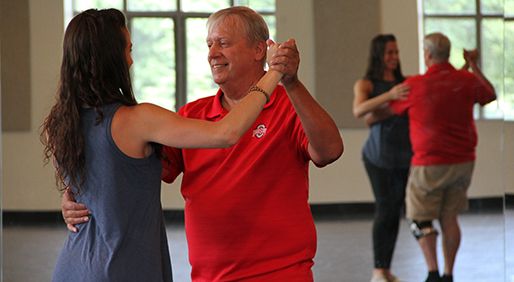Article
More Than Two Can Tango: Study Finds Many Benefits When Survivors Dance
Author(s):
A tango program for cancer survivors is showing to have benefits far beyond developing graceful dance moves.
Tim Hickey dances the Argentine tango with Mimi Lamantia to build strength and balance after surviving cancer. Like many patients, Hickey suffered from peripheral neuropathy, which can occur when chemotherapy damages nerves in the legs and feet, causing balance issues.(Photo courtesy of The Ohio State University Comprehensive Cancer Center)

Tim Hickey dances the Argentine tango with Mimi Lamantia to build strength and balance after surviving cancer. Like many patients, Hickey suffered from peripheral neuropathy, which can occur when chemotherapy damages nerves in the legs and feet, causing balance issues.(Photo courtesy of The Ohio State University Comprehensive Cancer Center)
Since beginning treatment for Hodgkin lymphoma in 2012, Tim Hickey struggled with his balance and was forced to use a wheelchair. Five months in remission, Hickey, who at the time needed a walker, embarked on a course of physical therapy. While traditional PT helped, this determined survivor found relief for his mobility challenges from another, unexpected source: dancing the Argentine Tango.
Research conducted by a team at The Ohio State University discovered that dance therapy — specifically the Argentine Tango — can counteract some of the balance and movement problems survivors like Hickey experience.
Up to 70 percent of survivors who have been treated with chemotherapy are affected by peripheral neuropathy, which can cause loss of sensation in the hands, fingers, feet and toes. One in three patients will continue to experience this problem six months after treatment.
Long-term neuropathy in the feet and toes can affect a person’s balance and gait, which is concerning because it increases the risk of the survivors falling and injuring themselves during their day-to-day activities.
A combination of traditional physical therapy and use of the rehabilitation biofeedback tool “embedded arts” helped Hickey “tremendously,” he says, and he graduated from a walker to a cane. But when his shoulder locked, and he needed a new approach, he found that the Argentine Tango group was just what he needed.
Led by Lise Worthen-Chaudhari, associate director of the Motion Analysis and Recovery Laboratory at The Ohio State University Wexner Medical Center, the study Hickey joined followed 31 participants, 25 of them cancer survivors.
When patients first began the dance therapy program, their standing postural sway (eyes closed) was measured with a computer-aided force platform. It was recorded again after attending dance therapy sessions twice a week for ten weeks with Mimi Lamantia, a pre-med and undergraduate dance major at Ohio State who inspired the study and instructed the participants.
After just five weeks, patients’ medial and lateral sway already had decreased by 56 percent, suggesting the tango as a potential method of controlling impaired balance post-treatment.
“Argentine Tango is a great example of doing all the practical motions — walking forward, walking backward, walking sideways — things you would do in physical therapy class,” Worthen-Chaudhari explains, because it combines strength, conditioning and aerobic components.
She also notes that the type of tango most Americans are familiar with is more of a dramatic, performance-based routine, with fast-moving feet and lots of poses. The Argentine tango, however, is a community dance.
“People go to a social club or a hall and do the dance for fun with their community, and it’s literally called the ‘walking dance.’ It’s not performative in the way we tend to think of tango.”
“There’s always a mind—body element in dance where the cognitive and neuro-motor have to work together,” Worthen-Chaudhari continues. “This is a really engaged dance and requires patients to work improvisationally. You have to own it — you can’t just follow directions.”
After starting the dance therapy, Hickey reports being able to do several activities he hadn’t been able to do since beginning his anticancer treatment in 2012.
“The balance is amazing. I can actually go out and hit a golf ball without falling down. I couldn’t run, I couldn’t jog. I can do that now.”
In addition to physical improvements, many participants reported they enjoyed the dance therapy far more than physical therapy, which is often hard and feels like work. Dance therapy, on the other hand, is fun and social, making people want to attend.
“More than just balance, I think the companionship of fellow survivors was a definite plus with the program,” Hickey said. “We all had that same weight on our shoulders that cancer brings. We all had a better disposition leaving the program than going into it. I would definitely recommend it not just for the mental part of it, but the physical part was fantastic, too.”
The feedback from participants overall on their satisfaction with the intervention bears this out:
“We asked questions such as, ‘Did you have more or less energy at the end of your last chemo session?’ notes Worthen-Chaudhari. “We found really high satisfaction with the intervention, and a lot of people had more energy at the end of the session. Instead of feeling like they had really worked out and they need to take a nap, people feel exhilarated.”
The next step in this research is to do a larger study with a control group to see if the positive results are replicated. Until then, traditional physical therapy is prescribed as the primary rehabilitation therapy.
“Right now, the recommendation would be to do the dance therapy as a supplemental activity,” Worthen-Chaudhari said. “It’s not going to hurt — it will only help.”
Echoes Hickey: “It has helped improve my outlook on life and my anticipation that there’s more life to come.”




